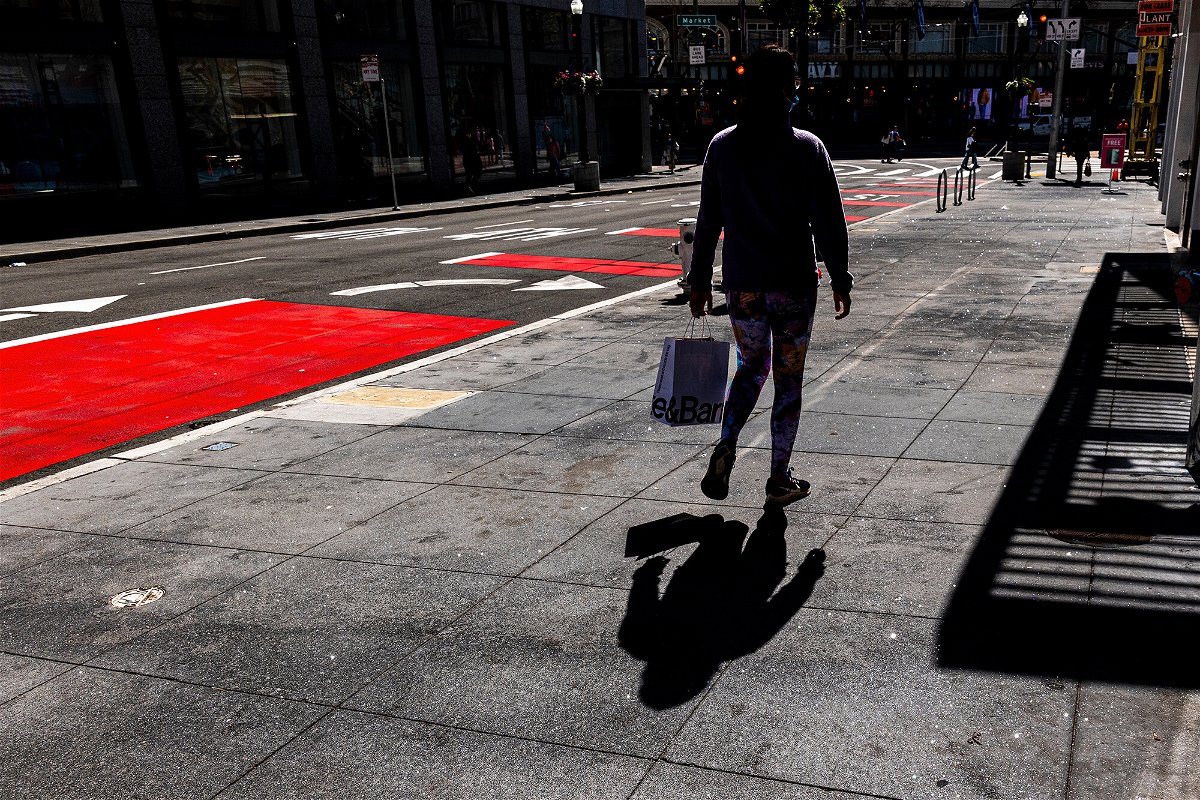The US economy contracted. Don’t panic

A pedestrian carries a shopping bag in San Francisco
By Matt Egan, CNN Business
The economic recovery from Covid-19 stumbled in the first quarter, but that doesn’t mean a recession is imminent.
Gross domestic product unexpectedly declined at an annual rate of 1.4% during the first three months of the year — the worst quarter for the American economy since the pandemic turned the world upside down in the spring of 2020.
However, economists say Thursday’s ugly — and confusing — GDP report is not a reason for panic, nor a harbinger of an immediate recession. It was distorted by temporary factors, most notably a massive trade deficit due to supply disruptions, that mask underlying strength in the economy.
“The negative GDP number is a surprise, but not a material one,” Moody’s Analytics chief economist Mark Zandi told CNN in an email. “The economy continues to grow strongly and at a pace that continues to bring down unemployment.”
The US economy will return to growth during the second quarter, according to RSM chief economist Joe Brusuelas. “Without a doubt,” he said.
“This is noise; not signal,” Pantheon Macroeconomics chief economist Ian Shepherdson wrote in a report. “The economy is not falling into recession.”
Consumers and businesses are spending
Although the headline GDP figure was gloomy, there were clear bright spots under the hood.
Consumer spending — the main driver of the US economy — accelerated during the first three months of the year. Personal consumption expenditures increased at a seasonally adjusted annual rate of 2.7%, compared to 2.5% during the fourth quarter of last year.
Companies are also spending on factories, equipment and software, investments that will boost productivity. Business investment surged at an annual rate of 9.2% in the first quarter, up from 2.9% during the fourth quarter.
“Although GDP fell in the first quarter, the US economy is not in recession. Underlying demand remains strong, and the labor market is in excellent shape,” PNC chief economist Gus Faucher wrote in a report. “Growth will resume in the second quarter.”
Trade turns GDP negative
However, many of the positives were offset by one-off factors.
Most notably, imports skyrocketed during the first quarter as US supply failed to meet soaring demand. That widening trade gap subtracted 2.5 percentage points from the GDP.
That means “surging imports accounted for more than all of the GDP decline,” said Goldman Sachs in a note, adding that this “likely reflected strong domestic demand” as well as some Ukraine-related front-loading of imports.
Beyond trade, GDP was depressed by Covid as Omicron shut down businesses and some pandemic relief to businesses and households decreased or stopped altogether.
Another factor: Businesses added to their inventories, but at a slower rate than the unsustainable pace of the fourth quarter of last year. That subtracted from GDP, too.
“I’m not concerned about recession,” President Joe Biden said Thursday, acknowledging the latest GDP report. “We also had, last quarter, consumer spending and business investment and residential investment increased at significant rates both for leisure as well as hard products.”
“I think … what you’re seeing is enormous growth in the country that was affected by everything from Covid and the Covid blockages that occurred along the way,” he said.
Inflation, war and lockdowns are risks
Even though the GDP report is not a reason to panic about today’s economy, there are risks on the horizon, and the chance of a recession in 2023 or 2024 has gone up.
The biggest problem is that inflation is very high, raising the specter of a boom-to-bust scenario. Worse, the outlook for prices to cool off is clouded by Covid lockdowns in China and the war in Ukraine.
High inflation has forced the Federal Reserve to contemplate the biggest interest rate hikes since 2000, meaning borrowing costs for mortgages, credit cards and car loans will rise. And those looming rate hikes are designed to slow down the economy.
The-CNN-Wire
™ & © 2022 Cable News Network, Inc., a WarnerMedia Company. All rights reserved.